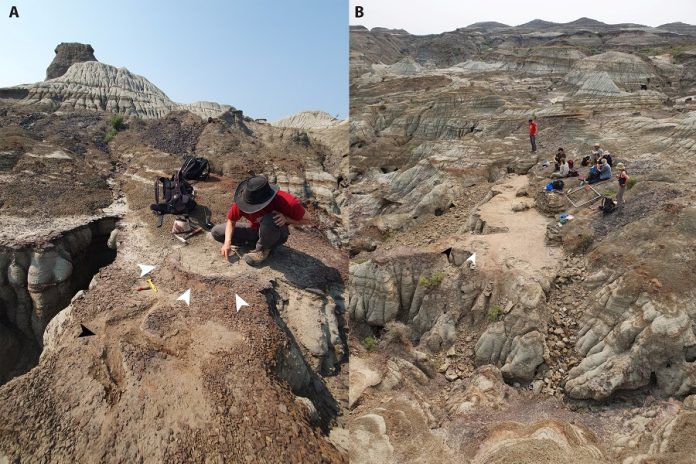
New dinosaur footprints found in Canada suggest that different species of dinosaurs may have traveled together in herds—similar to how zebras and wildebeest move across the plains in Africa today.
This exciting discovery was made in July 2024 by an international team of researchers in Dinosaur Provincial Park, Alberta, and has been published in the journal PLOS One.
The park is famous for its rich fossil history, but dinosaur footprints had rarely been found—until now.
The newly uncovered tracksite includes footprints from horned dinosaurs (ceratopsians), a likely armored dinosaur (ankylosaurid), and even a small meat-eating dinosaur.
Most excitingly, the tracks show at least five horned dinosaurs walking side by side, along with the possible ankylosaurid moving among them. This is the first clear evidence that dinosaurs of different species may have traveled together in a group.
Nearby, researchers also found two large tyrannosaur tracks walking side by side but moving in a different direction from the herd. The scientists suggest this could mean the herd was sticking together as a defense against predators like tyrannosaurs, but they need more evidence to be sure.
Dr. Phil Bell from the University of New England in Australia said he was surprised by the discovery. Although he has spent nearly 20 years studying dinosaur bones in the park, he hadn’t paid much attention to footprints before.
When he saw the muddy impressions in the rock, he immediately realized they could tell a new and important story.
Dr. Brian Pickles from the University of Reading in the UK described the experience as thrilling—walking in the same paths where dinosaurs once walked 76 million years ago. Thanks to this find, the team has already discovered several more tracksites in the park, and they believe there is much more to learn about how dinosaurs interacted and behaved.
Dr. Caleb Brown from the Royal Tyrrell Museum in Canada said the discovery shows that even in a place as well-studied as Dinosaur Provincial Park, there are still surprises waiting to be found.
After more than 100 years of digging up bones, scientists are only now beginning to see the full picture of how these incredible animals lived together.



